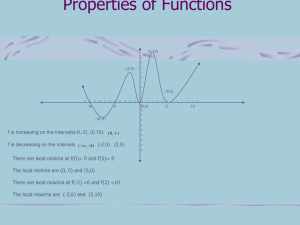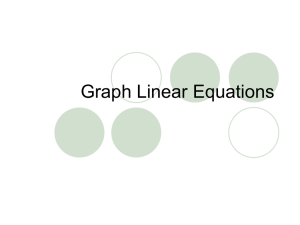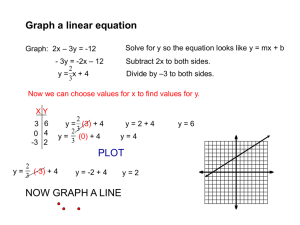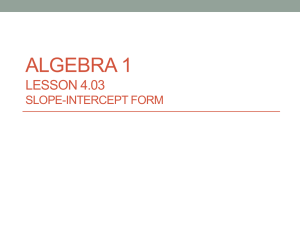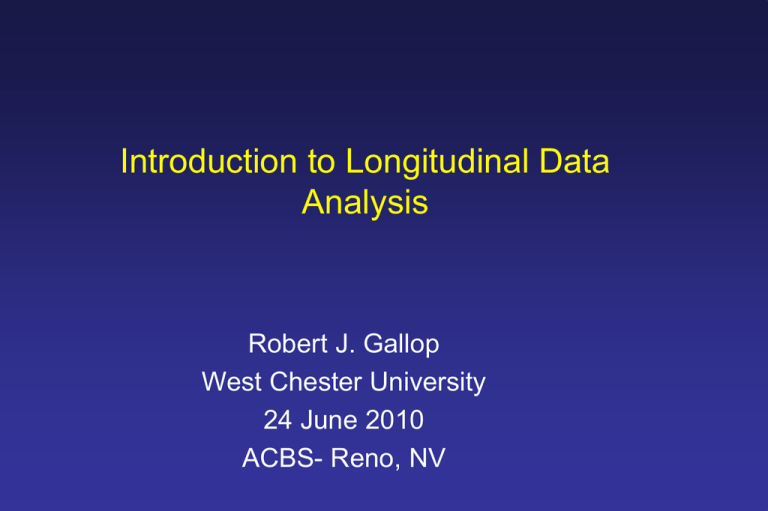
Introduction to Longitudinal Data
Analysis
Robert J. Gallop
West Chester University
24 June 2010
ACBS- Reno, NV
Longitudinal Data Analysis
Part 1 - Primitive Approach
Mathematician mentality
One day a mathematician
decides that he is sick of
math. So, he walks down to
the fire department and
announces that he wants to
become a fireman.
The fire chief says, "Well,
you look like a good guy. I'd
be glad to hire you, but first
I have to give you a little
test."
A problem
• The firechief takes the
mathematician to the alley
behind the fire department
which contains a dumpster,
a spigot, and a hose. The
chief then says, "OK, you're
walking in the alley and you
see the dumpster here is
on fire. What do you do?"
The mathematician replies,
"Well, I hook up the hose to
the spigot, turn the water
on, and put out the fire."
• The chief says, "That's
great... perfect.
A new problem, an old Solution
• Now I have to ask you just one
more question. What do you do if
you're walking down the alley
and you see the dumpster is not
on fire?"
The mathematician puzzles over
the question for awhile and he
finally says, "I light the dumpster
on fire."
The chief yells, "What? That's
horrible! Why would you light the
dumpster on fire?"
The mathematician replies,
"Well, that way I reduce the
problem to one I've already
solved."
Joke per http://www.workjoke.com/projoke22.htm
A lot of Data
Response Features Analysis
• Primitive Methods Corresponds to a respone
feature analysis (Everitt, 1995).
General Procedure
• Step 1 – Summarize the data of each subject into
one statistic, a summary statistic.
• Step 2 – Analyze the summary statistics, e.g.
ANCOVA to compare groups after correcting for
important covariates
What happens
• The LDA is reduce to the analysis of
independent observations for which we
already know how to analyze though
standard methods:
– ANOVA
– ANCOVA
– T-test
– Non-Parametrics
Is this Wrong? NO
• But, researchers have been interested for decades
in change within individuals over time, that is, in
longitudinal data and the process of change over
time.
Ways to Summarize the Data
•
•
•
•
•
Mean of the available scores
LOCF of the Score
Median of the Scores
Order Statistics of the Scores
Mean sequential change
Pros and Cons of Response Feature Analyses
•
•
•
•
BENEFITS
Easily done.
Commonly done.
Simplistic methods for
missing endpoints
(LOCF).
Easily interpretable /
Cohen’s D effect size
•
•
•
•
DRAWBACKS:
Throwing away a lot of
information.
May be Underpowered.
May be Overpowered.
LOCF may be biased.
Another way of Quantifying Change
Used a lot in Biopharmaceutical Applications
• Subject specific Area Under the curve (AUC)
(Matthews et al. ,1990).
• The advantages of the AUC is its easy derivation,
does not require balanced data, and compares the
overall difference between groups.
• The disadvantages of the AUC are we lose
information about the time process.
• Another disadvantage, to make the AUC
comparable between treatments, it requires the
AUC be measured in the same units. Thus with
dropout and the placebo group by design being half
as long as the other treatments, we will consider an
AUC per week, derived as the AUC divided by the
elapsed time.
Illustration of the derivation of AUC
Estimation Method
NEWSFLASH: Disadvantage
• LOTS of information is lost.
• They often do not allow to draw conclusions about
the way the endpoint has been reached.
• Impact of missing data on the derivation of the
summary score.
• Do the results mean anything?
Longitudinal Data Analysis
Part 2 – Hierarchical Linear Models
“Renaissance Approach”
R
a
n
d
o
m
i
z
at
i
o
n
DeRubeis and Hollon Example: Acute Phase
Weeks
(Single blind)
CT
(N= 60)
(Single blind)
ADM
(N= 120)
(Triple blind)
Augmented with Lithium or
Desipramine if no response
to Paroxetine after 8 weeks.
PLACEBO
(N= 60)
0
2
4
6
8
Un-blinding for
pill patients
10
12
14
16
PRIMARY Hypothesis:
Is there a difference in change over time
between the 3 treatment groups during
the first 8 weeks of treatment?
(COMPARATIVE GROUP IS PBO)
Study Design Concerns
KEEP THE LONGITUDINAL STRUCTURE
TYPE and AMOUNT OF DATA
STATISTICAL APPROACH TO ACCOUNT FOR
THE TYPE OF DATA WE HAVE.
POWER TO CONDUCT THE ANALYSIS
Modified 17-item Hamilton Rating
Scale for Depression
Hamilton Means for First 8 Weeks
26
24
22
20
18
16
14
12
10
8
6
4
2
0
Placebo
CT
ADM
16.2
14.7
13.3
Intake
0
2
4
Weeks
6
8
Types of Data
Classical univariate statistics assumes that each subject gives rise to
a single measurement, the response, on the outcome of interest.
Example: measure systolic blood pressure once on each subject.
Multivariate statistics assumes that each subject gives rise to
measurements on each of multiple outcomes of interest. Example:
measure systolic blood pressure, diastolic blood pressure, heart rate,
and temperature once on each person.
In Longitudinal data each subject gives rise to multiple
measurements of the same outcome of interest, measured at a sequence
of time points. Example: measure each subjects diastolic blood
pressure at each of five successive times after administration of a
pharmacological agent.
Longitudinal Data
Classical time series data consists of a single long series of measurements of the
same response on the same unit (subject).
Longitudinal data consists of a large number of short series of the same response on
the same unit.
Longitudinal studies have ability to separate cohort and age effects while crosssectional studies do not. That is, longitudinal studies can distinguish changes over
time within individuals (ageing effects) from differences among people in their
baseline levels (cohort effects). Cross-sectional studies do not have this feature.
Longitudinal data require special statistical methods to accommodate the
correlations within a set of multiple observations on the same subject. Valid
inferences cannot be made without consideration of this correlation structure.
Panel data is a term used by sociologists and economists to refer to longitudinal
data.
GOOD FEATURES OF A STATISTICAL MODEL
Feature
Useful
Necessary
Tests study
hypotheses
X
Appropriate to
study design
X
Appropriate to data
(e.g., missing,
non-normal,
adjustment
variables)
X
Has available,
reliable software
X
Estimates effect
sizes
X
Understandable
by knowledgeable
non-statisticians
X
LOCF Endpoint Analysis - Results
• Clinical trials
methodologists
recommend counting
all events regardless of
adherence to protocol
and comparing
originally randomized
groups. This strict
“intent-to-treat” policy
implies availability and
use of outcome
measures regardless of
adherence to treatment
protocol.
• F(2,235)=2.48, p=0.086
Treatment
ADM
LSMEAN
(Adjusted for
Baseline and
Site
Differences)
13.59
CT
14.48
Placebo
15.95
Endpoint Analysis Effect Size Issues
Contrast
ADM vs.
Placebo
Effect Size
Descriptora
Small to
medium
Effect Size (d)
0.35*
CT vs.
Placebo
0.22
small
ADM vs.
CT
0.15
small
*p< .05
a
From Cohen
We have Longitudinal data.
Do a Longitudinal Approach.
Benefits: Don’t throw anything away, more
information, more power, and it’s just makes
sense
Main Hypothesis: Interested in Change.
Take a Closer Look at your data
Modified 17-item Hamilton Rating
Scale for Depression
Hamilton Means for First 8 Weeks
26
24
22
20
18
16
14
12
10
8
6
4
2
0
Placebo
CT
ADM
Intake
0
2
4
Weeks
6
8
In Statistics/Mathematics, we think of the
slope when we think of change.
Hierarchical Linear Model -Multiple Levels
• Within patient level (LEVEL 1) - Multiple measurements across the acute
phase of treatment
• Between patient level (LEVEL 2) - How are the group of patients in CT
doing in comparison to the group of patients in ADM, compared to the
group of patients in PBO.
• LEVEL 1 consists of n (number of subjects) individual linear regressions.
Outcome is primary measurement (HRSD). Predictors are time and
individual time-varying subject measures.
• LEVEL 2 consists of using the individual intercept and slope estimates
from LEVEL 1 as outcomes. Predictors include treatment condition and
other time-invariance predictors (GENDER, MDD Diagnosis, etc.) .
These two outcomes (intercept and slope) makeup two linear regression
models.
• Each person’s intercept is allowed to deviate
from an overall population intercept per
treatment. (B0j)
• Each person’s slope is allowed to deviate
from an overall rate of change (slope) per
treatment. (B1j)
• We have population-averaged estimates and
subject-specific estimates.
• Our inferences will be on the populationaveraged estimates but accounting for the
subject specific.
Model Implementation Issues
• Uses all available information for a given subject;
therefore it is an intent-to-treat analysis. Ignores
missing data.
• Account for the longitudinal nature
• Easily implemented in SAS through PROC MIXED,
SPSS , HLM, MIXREG, and Mlwin.
How the Implementation works
Random Effects Assumptions
0 0 01
0i
N
,
2
0
1i
01 1
2
•~
eij ~ N (0, )
2
Depiction of Hierarchical Linear Model Analysis, HRSDs for the
First 8 Weeks
•16.2
•14.3
•13.3
Test Results
• Test of Difference in Slopes: F(2,231)=3.92, p=0.02
Treatment
ADM
CT
Placebo
LSMEAN
(Adjusted for
Baseline and
Site
Differences)
-1.21
-1.11
-0.86
Random Effects
•
•
•
•
Random Intercept variance = 36.02
Random Slope variance = 0.327
Covariance = -0.327
When the covariance is positive, it indicates
subjects with higher levels of baseline (intercept)
have larger rates of change (more positive).
• When the covariance is negative, it indicates
subjects with higher levels of baseline (intercept)
have smaller rates of change (more negative).
Longitudinal Data Analysis
Part 3 – Hierarchical Linear Models
“Easy Example with Slope Estimation
and Contrast Using SPSS/PASW”
Data: Example of Pothoff & Roy (1964)
GROWTH DATA
• They considers the
outcome measure as the
distance from the center
of the pituitary to the
maxillary fissure
recorded at ages 8, 10,
12, and 14 for 16 boys
and 11 girls.
• Figure shows the mean
profile per sex
Hypotheses
• Rate of Growth Difference across boys and
girls.
Subject Specific Profiles
Our Level 2 Equations
Data Requirements
• For Longitudinal Data Analysis, most
programs (if not all) require your data to be
stacked.
• That means if you picture your data as an
excel spreadsheet, per row of the
spreadsheet corresponds to one record per
patient/timepoint combination.
Part of the Data
Into SPSS -> Pull Down Menu
Estimates and Contrasts
Longitudinal Data Analysis
Part 4 – Random Effects in Growth
Example
Random Effects Assumptions
0 0 01
0i
N
,
2
0
1i
01 1
2
•~
eij ~ N (0, )
2
Back to the Subject Specific Profiles
What we see?
• Within sex, there is much variability in where
participants start (intercepts) but limited variability in
the individual slopes.
Question in Model Building?
• The main question is whether there is sufficient
variability in individual slopes to warrant the need to
model this within-person term. That is, is the model
which assumes no variability within sex in growth
(slopes) but assumes variability in baseline scores
(intercepts), the most parsimonious model for these
data
• Model Building looks for parsimony
CovTEST
How the model fitting?
Random Effects Building
Fit for Various Structures
Model
Random Intercept
Random Intercept
and Random Slope
(not correlated)
Random Intercept
and Random Slope
(correlated)
-2Restricted Log
Likelihood
433.7572
433.1509
432.5817
How many Random Effects
– The need for random effects is examined by comparison
of the likelihood function for nested models:
Test 1 - Random Intercept compared to Random
Intercept and Random Slope not correlated.
Test 2 - Random Intercept and Random Slope not
correlated compared to Random Intercept and Random
Slope Correlated.
• The asymptotic null distribution in the difference of -2loglikelihood is a mixture of chi-squares.
Comparing the Nested Model
Comparison
Test 1
Test 2
Difference in the 2Restricted Log
Likelihood between
the two models
0.6063
0.5692
Mixture of Chi-squares
Comparison
Test 1
Test 2
Chi-square
Mixture value
4.915
6.900
Results for the Growth Data
• This implies there is no subject-to-subject
variability in the individual slopes compared
to the overall gender specific average slope.
Issues
• The reliability estimate for a random effect parameter is the ratio of the
parameter variance divided by the sum of the parameter variance and
the error variance.
• This represents the proportion of variance attributed to true subject-tosubject heterogeneity.
• For the growth data, the reliability estimate for the random slopes of
0.004.
• Raudenbush and Bryk (2002) discuss that when reliabilities become
small (<0.05), the variances are likely to be close to 0, which may result
in convergence problems for MLM software packages.
0 variance estimates
(more on this later too)
• The software program may result in a variance component
of 0 for the highest order term, such as the random slope.
• This 0 estimate is saying there is no subject-to-subject
heterogeneity from the group average for the specified
random effect.
• The investigator must ask if this is truly the case or are the
data too limited in size to assess the subject-to-subject
heterogeneity. The statistical significance testing of the
random effect terms through the mixture of chi-squares,
visual inspection of the subject-to-subject difference, and
derivation of the reliability index can assist the investigator.
Random Intercept only model
• To derive a slope, we need at least two points. Not all
subjects will have an individual slope, such as subjects who
are randomized but do not attend treatment.
• When an investigator fits only a random intercept model, this
results in a variance-covariance matrix of the outcome
measures having a compound symmetry design.
• Compound symmetry assumes a common variance at each
assessment and a common covariance/correlation between
any pair of assessments within a subject. So if an
investigator has 6 repeated measures and fits an MLM with
only a random intercept, then this model will assume the
correlation between time 1 and time 2 is the same as the
correlation between time 1 and time 6, for example.
Longitudinal Data Analysis
Part 5 – Modeling time flexibly
“You can see a lot, just by looking”—Yogi Berra
Treatment Effect Study
Model the Data, not put the data into a model
• The basic formation of the longitudinal HLM considers time
as linear.
• If one does not expect the outcome to change across time in
a linear fashion, then a refinement of the model is required.
• Linear time assumes the rate of change is consistent across
the entire longitudinal period under investigation.
• Empirical evidence is accumulating that change during
treatment is non-linear.
• More precise models of change may elucidate unique
clinical characteristics of different treatments and may
identify possible mechanisms of change.
A Change of Scale for Time
• As can be seen, the data do not support linear
change over time because there is a rapid reduction
in the first 30 days followed by less pronounced
reduction. Therefore, treating time as linear is not
appropriate. A solution is to transform time to a
shifted logarithm of time, resulting in a near linear
mean profile of change over time. Level 1 equation
is:
yij= β0j + β1j[log(timeij+1)] + eij,
Trajectories
Build the appropriate mathematical relationship
• Warning: More complex the mathematical
relationship, the more difficult it is to interpret it.
• Warning: You may not be able to fit all variance
components. So some variance estimates may be
going to 0 due to convergence issues (i.e. random
quadratic term).
Background on the Piecewise Model
• It is quite common in an RCT to see an initial phase of
substantial change followed by a second phase with reduced
change.
• Keller et al. (2000) in a 12 week study found two phases of
change over time with the distinct phases corresponding to
change from baseline to week 4 and change from week 4 to
week 12. This type of change over time structure is
modeled as a piece-wise linear model, where rates of
change are allowed to differ between the two phases.
• In essence, two rates of change connected at a point of
change referred to as a breakpoint, are estimated for each
subject.
Graphical depiction of a Piecewise Model
Timing of the Break
The location of this breakpoint is at times determined
by study design features such as:
•
•
•
•
location of mid-point of the study,
change in frequency of assessment,
change in medication regimen,
progressing from active treatment phase to a followup phase.
Getting the two legs of time
Original Time1
time
0-4
0
0
2
2
4
4
6
4
8
4
10
4
12
4
Time2
4-12
0
0
0
2
4
6
8
COMPUTE time1 = min(time,4) .
COMPUTE time2=max(0, time-4).
EXECUTE .
SPSS Syntax
MIXED
hmcdtot BY cid cond WITH time1 time2
/CRITERIA = CIN(95) MXITER(100) MXSTEP(5)
SCORING(1)
SINGULAR(0.000000000001) HCONVERGE(0,
ABSOLUTE) LCONVERGE(0, ABSOLUTE)
PCONVERGE(0.000001, ABSOLUTE)
/FIXED = cond time1 cond*time1 time2 cond*time2 |
SSTYPE(3)
/METHOD = REML
/PRINT = COVB SOLUTION TESTCOV
/RANDOM INTERCEPT time2 | SUBJECT(clientid)
COVTYPE(VC)
/EMMEANS = TABLES(cond) COMPARE ADJ(LSD)
/TEST = 'D SLOPE-LEG 1' time1 1 cond*time1 1 0
/TEST = 'T SLOPE-LEG1' time1 1 cond*time1 0 1
/TEST ='Diff Trend Test - LEG1' cond*time1 1 -1
/TEST = 'D SLOPE-LEG 2' time2 1 cond*time2 1 0
/TEST = 'T SLOPE-LEG2' time2 1 cond*time2 0 1
/TEST ='Diff Trend Test - LEG2' cond*time2 1 -1.
Custom Hypothesis Test 1 (DC SLOPE-LEG 1)
Contrast Estimates a,b
Contrast
L1
Estimate
-1.63824
Std. Error
.4620497
df
192.379
Test Value
0
t
-3.546
Sig.
.000
95% Confidence Interval
Lower Bound
Upper Bound
-2.5495726
-.7269051
a. D SLOPE-LEG 1
b. Dependent Variable: Ham-D Score.
Custom Hypothesis Test 2 (DBT SLOPE-LEG1)
Contrast Estimates a,b
Contrast
L1
Estimate
-1.73231
Std. Error
.5104759
df
202.816
Test Value
0
t
-3.394
Sig.
.001
95% Confidence Interval
Lower Bound
Upper Bound
-2.7388276
-.7257868
a. T SLOPE-LEG1
b. Dependent Variable: Ham-D Score.
Custom Hypothesis Test 3 (Diff Trend Test - LEG1)
Contrast Estimates a,b
Contrast
L1
Estimate
.0940683
Std. Error
.6885314
a. Diff Trend Test - LEG1
b. Dependent Variable: Ham-D Score.
df
198.085
Test Value
0
t
.137
Sig.
.891
95% Confidence Interval
Lower Bound
Upper Bound
-1.2637241
1.4518607
Polynomial Model
Quadratic Model
MIXED
ratio360 BY p_id cat WITH centdayc centsq cent3
/CRITERIA = CIN(95) MXITER(100) MXSTEP(5)
SCORING(1)
SINGULAR(0.000000000001) HCONVERGE(0,
ABSOLUTE) LCONVERGE(0, ABSOLUTE)
PCONVERGE(0.000001, ABSOLUTE)
/FIXED = cat centdayc cat*centdayc centsq
cat*centsq | SSTYPE(3)
/METHOD = REML
/RANDOM INTERCEPT | SUBJECT(p_id)
COVTYPE(UN) .
Cubic Change
MIXED
ratio360 BY p_id cat WITH centdayc centsq
cent3
/CRITERIA = CIN(95) MXITER(100)
MXSTEP(5) SCORING(1)
SINGULAR(0.000000000001)
HCONVERGE(0, ABSOLUTE) LCONVERGE(0,
ABSOLUTE)
PCONVERGE(0.000001, ABSOLUTE)
/FIXED = cat centdayc cat*centdayc centsq
cat*centsq cent3 cent3*cat| SSTYPE(3)
/METHOD = REML
/RANDOM INTERCEPT | SUBJECT(p_id)
COVTYPE(UN) .
Another Example
Slopes
• From baseline to post-intervention, IPT-AST adolescents
showed significantly greater rates of change on the CGAS
(t(52) = 3.40 p < 0.01) than SC adolescents.
• In the 6 months following the intervention, there was a
marginal difference in rates of change on the CGAS (t(52) =
-1.88, p = 0.06).
• Active phase Slopes were 2.95 ± 0.45 for IPT and 0.43 ±
0.59 for SC
• Followup Slopes were 0.91 ± 0.46 for IPT and 2.35 ± 0.62
for SC.
• Basically SC catches back up during the followup period.
Longitudinal Data Analysis
Part 6 – Missing Data
Missing data are inevitable, especially with
dropouts, but the key issue is whether the
inferences are impacted by the
presence/absence of the data.
Missing Data in the HLM Framework
• Missing data are not imputed
• The individual regression lines are fit ignoring
missing data. We call this MAR.
• Missing Data must be non-informative for proper
interpretation
• Informative missing data models - Pattern Mixture
Model may need to be considered.
HLM does not impute Data
Subject Specific Imputed Data (n=4 subjects)
(original scores are YY)
ID
y0
yy0
y1
yy1
6
7.37
11
y2
yy2
y3
7.37
24.68
24.68
0.19
.
5.40
26.75
26.75
37.40
37.40
64.62
64.62
12
25.34
25.34
77.07
77.07
21.75
14
89.62
89.62
64.77
64.77
87.43
yy3
y4
yy4
y5
5.40
42.01
42.01
37.81
37.81
36.21
36.21
17.72
17.72
21.75
34.22
34.22
17.42
17.42
40.55
40.55
.
35.70
35.70
55.32
.
16.22
16.22
15.04
yy5
.
Results based on Missing Data
Covariance
Parameter
Terms
Intercept
Complete
Data
Incomplete
Data
Imputed
Data based
On Ind. Regress
478.15
458.39
481.34
Time
1.9775
5.9425
5.8899
Residual
257.41
233.61
182.46
Log-Likelihood
-233.8
-215.5
-252.8
Time Effect pvalue
0.254
0.279
0.189
TOO MUCH MISSINGNESS?
What good is a Subject with only 1 value?
ID
time
21
y
0
14
Random
Effect
ID
Estimate
se
DF
tValue
Probt
Intercept
21
-9.7585
13.1554
30
-0.74
0.4640
time
21
0
2.3471
30
0.00
1.0000
Impact of Subjects with only 1 time point
• They are included in the analysis. Full ITT.
• They help the estimation of the random Intercept
term
• They help the estimation of the within residual error
• Their slope is set to the “population-averaged”
slope.
HLM models assume that data are missing at
random (MAR),
• MAR means the missing data process is independent of the
value of the outcome variable (e.g., depression scores) but
can depend on some other observed variable in the study
(e.g., race, gender, and treatment condition).
• For example, in the Gibbons et al. (1993) article, there is a
significant difference in attrition between interpersonal
psychotherapy (IPT) and placebo (2(1,N=123)=4.29,
p<0.04) where attrition rates were 23% and 40%
respectively. Although the attrition rates were differential,
this did not impact the difference between treatment
conditions on rate of change on log-week scale.
Why is Data Missing
• With respect to treatment condition, studies often report
differential attrition but differential attrition does not mean
that dropping out is related to outcome.
• The informative dropout mechanism depends on whether
there is a story on why the data are missing. When the
missing data process depends on the value of the outcome
variable, then the missing data are said to be informative
(Rubin, 1976).
• To assess if the missing data are informative, one common
approach is to implement pattern-mixture models.
Pattern Mixture Model
• As described by Hedeker & Gibbons (1997), this approach
allows us to assess whether important estimates (i.e.,
change in outcome over time per condition in the HLM) are
dependent on missing data patterns, i.e., informative.
Separate treatment effects are estimated for specified
missing data patterns and then an overall treatment effect is
calculated as a weighted average of the treatment difference
over the patterns.
• Patterns are defined with respect to both what data are
present and what data are missing. To apply the pattern
mixture approach, ideally, one would indicate a separate
effect for each distinct pattern and inspect any treatment
differences across patterns.
How many patterns
• Realistically, the number of patterns examined must be
manageable. Typically, various patterns are combined and
often reduced to two clinically meaningful patterns: e.g.,
completers and dropouts, as was done in the Hedeker &
Gibbons (1997) example and the Dimidjian et al. (2006)
depression study.
• The number of patterns which can be fit is a trade-off with
the number of distinct patterns present in the data and the
amount of data present both with respect to number of
subjects and number of repeated measures.
• Specification of more patterns than the two defined above
may result in zero cells for a given treatment condition and
pattern.
Assessment of Informativeness
• If the estimate of interest (i.e. the differential rate of change
between conditions) is dependent on missing data patterns,
then the missing data are informative.
• we assume the pattern is binary coded as 0 for dropouts and
1 for completers.
Illustration of the Pattern Mixture Model
• To illustrate the pattern-mixture approach, we use data from
the Hedeker & Gibbons (1997) and the Dimidjian et al.
(2006) studies.
• n the Hedeker & Gibbons (1997) article, change in the
outcome (slopes) was compared across medication (DRUG)
versus placebo (PBO) conditions.
• In the Dimidjian et al. (2006) study, we consider two groups
for which change in outcomes were compared: medication
condition (ADM) versus cognitive therapy (CT) condition.
Report of Results
• Implementation of the pattern mixture model as reported in
Hedeker & Gibbons (1997) resulted in a significant threeway interaction between condition by time by pattern
(associated with the γ13 parameter in equation (5)),
F(1,686)=10.48, p<0.002.
• Whereas as reported in Dimidjian et al. (2006) study, the
model resulted in a non-significant three-way interaction
between condition by time by pattern in the analysis of
depression as measured by the Hamilton rating depression
scale (HRSD) for the high severity sample, F(2,185)=0.16,
p=0.86.
Slope Estimates
1.40
1.30
1.20
1.10
1.00
0.90
0.80
0.70
0.60
0.50
0.40
0.30
0.20
0.10
0.00
1.32
0.98
0.93
0.72
0.6
0.39
0.35
0.14
DRUG
PBO
Completer
ADM
Dropout
CT
Hedeker and Gibbons results
• The Hedeker & Gibbons (1997) example illustrates that the
treatment effect across time is dependent on dropout, which
corresponds to a significant γ13 parameter estimate. We
see that the DRUG condition resulted in larger slopes,
regardless of completion status, but DRUG condition
patients who dropped out had larger slopes compared to the
study completers.
• For the PBO condition, the effect is reversed, with patients
who completed treatment having, on average, larger slope
compared to dropouts. Therefore, the difference of the
treatment effect across patterns indicated that the treatment
group contrast was dependent on dropout pattern.
Dimidjian et al results
• For the Dimidjian et al. (2006) study, completers performed
best regardless of treatment, i.e., ADM or CT.
• But our main inference focused on the difference in the rate
of change over time between groups. For completers, the
difference in slope estimates between ADM and CT was
0.26.
• For dropouts, the difference in slope estimates between
ADM and CT was 0.25.
• Contrast this to the difference between DRUG and PBO for
completers and dropouts in the Hedeker & Gibbons
example, which were 0.54 and 1.18, respectively.
More on Hedeker and Gibbons results
• The significant effect is referred to as an ordinal
interaction effect of treatment with pattern. Hence,
the treatment effect is not generalizable, and must
be discussed dependent on the informative pattern
of missing data.
Longitudinal Data Analysis
Part 7 – Mathematical and Syntax
Background
General Linear Mixed Model
y X Z
where Z is the design matrix of random variables
is the vector of random - effect parameters
is no longer required to be independent & homogeneous
The general linear mixed model introduces random effect parameters and
allows a more flexible specification of the error covariance matrix.
The matrix Z can contain both continuous predictors and / or dummy
variables. The model is called mixed because it contains a mixture of
fixed effects, X , and random effects, Z .
Mixed Model – Variance Terms:
MATHEMATICS BEHIND TOTAL
VARIANCE IN MIXED MODELS
Var (Y ) ZGZ R
T
• Z = Design Matrix for the Random Effects
• G = Covariance Matrix for the Random Effects
• R = Residual Covariance Matrix
• G matrix is modeled through the Random Statement
• R matrix is modeled through the Repeated Statement
Goal in the Analysis of LDA
• Properly account for the clustering of the repeated measures
per subject.
• You can do this based on subject-specific level (Like HLM).
• You can do it based on a population-average approach,
where you don’t care about the subject-specific level, but
focus rather on specifying the variance-covariance of the
outcome measure.
Subject-Specific Approach
RANDOM
/RANDOM Intercept time |Subject(P_ID)COVtype(UN)
Population-averaged approach focus on R
Shapes/FORMS of R
• The form is blocked by subject based on the
available information for the given individual.
• Creates a blocked diagonol form.
• Same for everybody? YES, just like a pooled MSE
in ANOVA.
• There’s a lot of flexibility here. But let’s consider
when we have 3 repeated measures.
Independence
0
0
2
0
2
0
0
0
2
Compound Symmetry
1
1
2
1
2
1
1
1
2
Autoregressive
1
2 1
2
1
2
1
1
1
2
2
Toeplitz
1
2
2
1
2
1
2
1
2
Unstructured
12
13
2
1
12
2
2
23
13
23
2
3
Summarizing all Others:
When would you focus on the population
averaged approach?
• MMANOVA
Longitudinal Data Analysis
Part 8 – Mixed Model Analysis of Variance Model
Example from Crits-Christoph et al. (1999)
NIDA Cocaine Collaborative Treatment Study
MMANOVA background
• Similar to a Repeated Measures ANOVA, in that it models the on-average
estimate for a given longitudinal range.
• Differs from Repeated Measures ANOVA because it relaxes the Compound
Symmetry Assumptions in Repeated Measures ANOVA and does allow for
randomly missing assessments.
• Data inputed for analysis must be longitudinal format.
• Estimating the average Cocaine Usage during Active phase of treatment
post baseline.
• The key difference between this model and HLM modeling is that time is
considered here as a categorical classification variable as opposed to a
continuous covariate. Specifically, the mixed model approach estimates a
separate mean for each time, while the HLM modeling method estimates
monthly means using a linear or polynomial regression equation.
Benefits of this approach
•
•
•
•
•
•
•
This model allows for randomly missing observations.
Missing observations are simple deleted without dropping
the subject unlike multivariate ANOVA (MANOVA).
Covariates can be included in the model as either time
varying or invariant.
A wide range of possible covariance structures can be
modeled, unlike repeated measures ANOVA.
It allows for the estimation of person-specific trends
(random effects).
This method can easily be extended to accommodate
binary and ordinal outcome variables.
There is no debate about how to adjust for baseline data.
Baseline is included as a covariate and outcome
responses range include all post-baseline responses
(suped up ANCOVA)
This approach does not force you to assume that there is a
linear relationship between time and the outcome variable.
Problems with this approach
•
•
If there is a linear relationship or polynomial relationship
between time and the outcome variable, this model
provides a less powerful analysis than the multilevel
modeling construct.
This method requires that assessments be made at
discrete time points, such as month 1, 2, 3, etc. (Although,
this is the case with the NIDA Collaborative Cocaine
Treatment study.)
We don’t see a linear change
• MMANOVA post-baseline
• Control for baseline
MMANOVA - How to in SPSS.
Importance of Covariance
Structures
• Covariance structures
– model all the variability in the data, which cannot be
explained by the fixed effects
– represent the background variability that the fixed
effects are tested against
– must be carefully selected to obtain valid inferences
for the parameters of the fixed effects.
– We want parsimony but still account for the
clustering/correlation due to the repeated measures.
Evaluating Covariance Structures
Information Criteria
● Akaike Information Criteria (AIC) tends to choose more complex models
● -2 REML (Lowest is best)
● Schwarz Bayesian Information Criteria (BIC) tends to choose simpler models
● Because excessively simple models have inflated Type I error rates, AIC
appears to be the most desirable in practice
Based on simulation studies by Guerin and Stroup (2000), the AIC or -2REML
are preferable, especially when used in conjunction with the Kenward-Rogers
(KR) method for adjusting the degrees-of-freedom. On the other hand, using too
complex a model reduces power. For small samples, use the AICC which corrects
for small samples.
Quantification
• Take the difference of the -2RLL between the two models.
• Take the difference in the number of parameters in the
covariance structures.
• Difference follows a Chi-square distribution with degrees of
freedom equal to the difference in the number of parameters
in the covariance structures.
• If the difference exceeds the upper 5th percentile then the
more complex structure is warranted.
Longitudinal Data Analysis
More topics
Topics not covered
•
•
•
•
Non-Continuous outcomes.
3-level models.
Bioequivalence.
Power and Effect size derivations.
• Questions: rgallop@wcupa.edu

